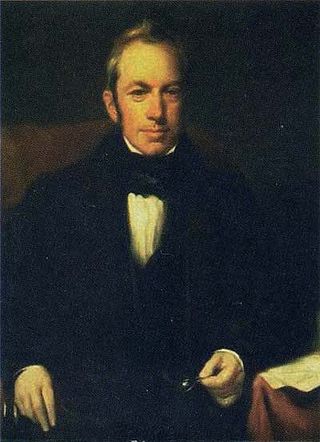
Robert Brown was a Scottish botanist and paleobotanist who made important contributions to botany largely through his pioneering use of the microscope. His contributions include one of the earliest detailed descriptions of the cell nucleus and cytoplasmic streaming; the observation of Brownian motion; early work on plant pollination and fertilisation, including being the first to recognise the fundamental difference between gymnosperms and angiosperms; and some of the earliest studies in palynology. He also made numerous contributions to plant taxonomy, notably erecting a number of plant families that are still accepted today; and numerous Australian plant genera and species, the fruit of his exploration of that continent with Matthew Flinders.
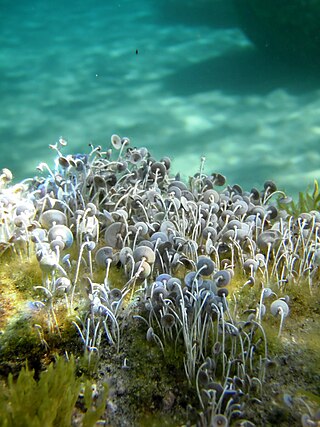
Acetabularia is a genus of green algae in the family Polyphysaceae, Typically found in subtropical waters, Acetabularia is a single-celled organism, but gigantic in size and complex in form, making it an excellent model organism for studying cell biology. In form, the mature Acetabularia resembles the round leaves of a nasturtium, is 4 to 10 cm tall and has three anatomical parts: a bottom rhizoid that resembles a set of short roots; a long stalk in the middle; and a top umbrella of branches that may fuse into a cap. Unlike other giant unicellular organisms, which are multinucleate, Acetabularia has a single nucleus, located in the rhizoid and allows the cell to regenerate completely if its cap is removed. The caps of two Acetabularia may also be exchanged, even from two different species. In addition, if a piece of the stem is removed, with no access to the nucleus in the rhizoid, this isolated stem piece will also grow a new cap.

Francis Walker was an English entomologist. He was born in Southgate, London, on 31 July 1809 and died at Wanstead, England on 5 October 1874. He was one of the most prolific authors in entomology, and stirred controversy during his later life as his publications resulted in a huge number of junior synonyms. However, his assiduous work on the collections of the British Museum had great significance.
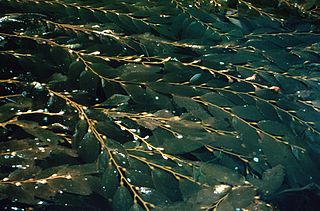
Macrocystis is a monospecific genus of kelp. This genus contains the largest of all the phaeophyceae or brown algae. Macrocystis has pneumatocysts at the base of its blades. Sporophytes are perennial and the individual may live for up to three years; stipes/fronds within a whole individual undergo senescence, where each frond may persist for approximately 100 days. The genus is found widely in subtropical, temperate, and sub-Antarctic oceans of the Southern Hemisphere and in the northeast Pacific from Baja California to Sitka, Alaska. Macrocystis is often a major component of temperate kelp forests.

William Henry Harvey, FRS FLS was an Irish botanist and phycologist who specialised in algae.
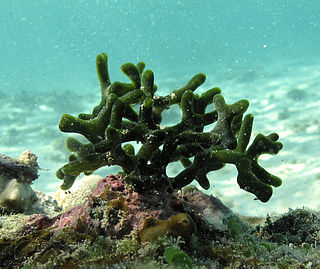
Codium is a genus of edible green macroalgae under the order Bryopsidales. The genus name is derived from a Greek word that pertains to the soft texture of its thallus. One of the foremost experts on Codium taxonomy was Paul Claude Silva at the University of California, Berkeley. P.C. Silva was able to describe 36 species for the genus and in honor of his work on Codium, the species C. silvae was named after the late professor.
The history of phycology is the history of the scientific study of algae. Human interest in plants as food goes back into the origins of the species, and knowledge of algae can be traced back more than two thousand years. However, only in the last three hundred years has that knowledge evolved into a rapidly developing science.

Vanvoorstia bennettiana is an extinct red algae from Australia. It is named after naturalist George Bennett.

Conceptacles are specialized cavities of marine and freshwater algae that contain the reproductive organs. They are situated in the receptacle and open by a small ostiole. Conceptacles are present in Corallinaceae, and Hildenbrandiales, as well as the brown Fucales. In the Fucales there is no haploid phase in the reproductive cycle and therefore no alternation of generations. The thallus is a sporophyte. The diploid plants produce male (antheridia) and female (oogonia) gametangia by meiosis. The gametes are released into the surrounding water; after fusion, the zygote settles and begins growth.
Amelia Griffiths (1768–1858), often referred to in contemporary works as Mrs Griffiths of Torquay, was a beachcomber and amateur phycologist who made many important collections of marine algae specimens.

Pediastrum duplex is a species of fresh water green algae in the genus Pediastrum.
Henry Watts (1828–1889) was an Australian amateur collector of Algae specimens. He is considered "the pioneer of freshwater phycology in Victoria".
Alfred Douglas Hardy was an Australian amateur collector of freshwater algae specimens.
George Clifton (1823–1913) was an English collector of seaweed specimens, active in Australia.
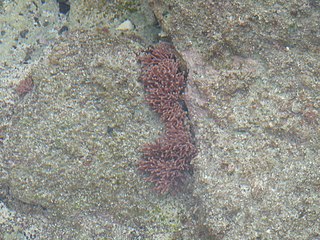
Amphiroa is a genus of thalloid red algae under the family Corallinaceae.
Elizabeth Andrew Warren was a Cornish botanist and marine algologist who spent most of her career collecting along the southern coast of Cornwall. Her goal was to create a herbarium of indigenous plants of Cornwall, and to this end she organized a network of plant collectors for the Royal Horticultural Society of Cornwall and provided numerous specimens to William Hooker at Kew Gardens for his study of British flora.

Batrachospermaceae is a family of fresh water red algae (Rhodophyta). Genera within the Batrachospermaceae generally have a "Lemanea-type" life history with carpospores germinating to produce chantransia. Sporophyte phase with meiosis occurs in an apical cell to produce the gametophyte stage. Pit connections have two pit plug cap layers with the other layer enlarged. This family of freshwater red algae is uniaxial, meaning each filament with a single apical cell. The genera included within Batrachospermaceae are listed in the table below.

Michael Dominic Richard Guiry, is an Irish botanist, who specialises in phycology (algae). See for example the articles. He is the founder and director of the algal database, AlgaeBase.

Amphiroa beauvoisii is a species of thalloid red algae in the Corallinaceae family. It is widely distributed across the world, and can be found attached to rocks in intertidal areas. Individual organisms consist of a base of calcified material, tissue in the shape of branching fan-like planes growing out of it. It exhibits a wide range of morphologies based on where it is found, as well as different reproductive behaviors based on season and location.
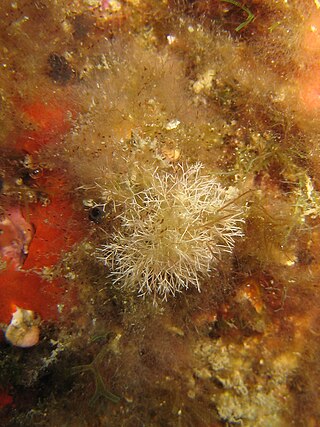
Liagoraceae is a family of red algae (Rhodophyta) in the order Nemaliales. The type genus is LiagoraJ.V.Lamouroux.













